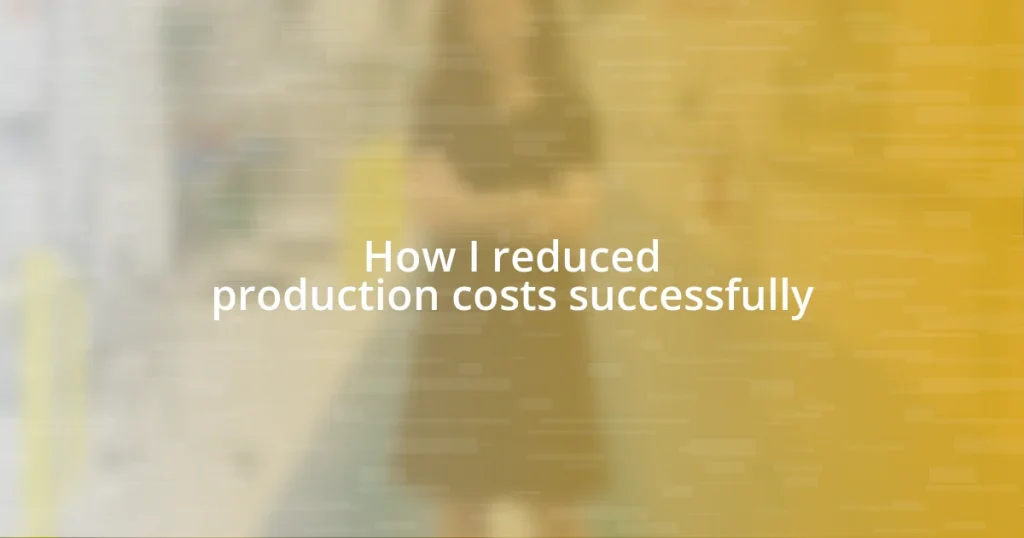Key takeaways:
- Identifying and addressing hidden costs in production, such as waste and inventory practices, can lead to substantial savings and improved financial health.
- Investing in technology, consolidating overlapping functions, and fostering a culture of continuous improvement can significantly enhance operational efficiency and employee morale.
- Regularly negotiating supplier contracts and measuring the impact of cost reductions helps maintain financial benefits and encourages ongoing innovation within the organization.

Understanding production costs
Understanding production costs is essential for any business owner looking to optimize their operations. In my own experience, I once noticed that many costs were hidden within the supply chain that I hadn’t accounted for, such as transportation fees and storage costs. Have you ever found unexpected expenses creeping up on you, too?
When I started reassessing my production costs, I realized that both fixed costs—like rent and salaries—and variable costs—like raw materials and manufacturing—play significant roles in overall financial health. It was eye-opening to see how slight changes in these areas could lead to substantial savings; even renegotiating contracts with suppliers can yield impressive benefits. Have you taken the time to break down your costs to see where you might save?
I remember the moment I discovered that waste in production not only affected efficiency but also directly impacted my bottom line. Cutting down on waste wasn’t just about being eco-friendly; it was also a strategic move that boosted my profits. Reflecting on your own production processes, are there areas where you could minimize waste to enhance your financial outcomes?

Identifying cost reduction opportunities
Identifying cost reduction opportunities requires a keen eye for detail and a willingness to dive deep into your operations. I remember a particularly revealing moment during a routine audit when I discovered a staggering amount of overspending due to overstocking materials. By shifting to a just-in-time inventory system, I was able to reduce not only storage costs but also minimize waste, which ultimately improved cash flow. Sometimes, just looking at your inventory practices can unveil excellent opportunities for savings that you never anticipated.
To pinpoint potential areas for cost savings, consider the following steps:
- Analyze each expense category thoroughly to identify any anomalies or excessive costs.
- Consult with team members to gather insights on resource utilization and potential waste in their processes.
- Compare supplier pricing and explore alternative vendors for better rates.
- Evaluate technology in use and seek out solutions that could automate or streamline operations, reducing labor costs.
- Monitor production timelines to identify bottlenecks and delays that increase costs unnecessarily.
By following these steps, you can pave the way to significant cost reductions in your production process, making it easier to boost profitability.

Streamlining operational processes
When I focused on streamlining my operational processes, I immediately noticed how essential it was to eliminate redundancies. For example, during a team meeting, we discussed our workflows and discovered that two departments were performing similar tasks. This overlap not only created confusion but also wasted valuable resources. After consolidating those functions, we saved precious time and enhanced clarity in our operations. Have you considered how your teams interact?
One of my key strategies was investing in automation tools. At first, I was hesitant, thinking that upfront costs could overwhelm my budget. However, after implementing a project management software, I saw a transformation in productivity. Tasks that once took hours now took minutes, allowing my team to focus on more strategic initiatives. This shift not only boosted morale but also created a significant ripple effect on overall efficiency. Have you explored technology’s role in your processes?
Lastly, adopting lean practices has truly changed the game for me. I embraced the idea of continuously assessing my workflows and making small adjustments over time. For example, I began to hold regular feedback sessions with my team to gather insights on bottlenecks and challenges they faced. This collaborative approach not only empowered my staff but also led to innovative solutions that dramatically cut down production time. How often do you engage with your team to improve processes?
| Strategy | Impact |
|---|---|
| Consolidating Overlapping Functions | Saved time and resources |
| Investing in Automation Tools | Increased productivity and morale |
| Adopting Lean Practices | Encouraged continuous improvement and innovation |

Leveraging technology for savings
Imagine walking into your workspace and seeing tasks being done manually that could easily be automated. That was my reality when I first started examining technology’s role in my operations. I can still recall standing over my team’s shoulders, watching them input data into spreadsheets, and feeling a mix of sympathy and frustration. After researching and implementing a user-friendly software solution, I was blown away by how quickly it transformed our workflow. It wasn’t just about saving time; it was about freeing my team to engage in more creative tasks that invigorated their enthusiasm. Have you ever considered how much potential is lost when repetitive tasks consume your time?
When I introduced data analytics tools, it opened a new world of insight. For instance, I remember analyzing production data and pinpointing inefficiencies that hadn’t even been on my radar. The ability to visualize trends and spot anomalies was like switching on a light in a dark room. Suddenly, we were not just following gut feelings; we were making informed decisions that dramatically cut down costs. This newfound clarity was exhilarating. Have you thought about how data could enhance your decision-making process?
Moreover, I couldn’t overlook the impact of cloud technology. Transitioning to a cloud-based system removed the barriers of traditional IT infrastructure, allowing our team to collaborate seamlessly from anywhere. I remember the first time my colleagues stayed productive while working from home during a storm. It was eye-opening to see that flexibility didn’t just maintain our output; it actually inspired higher engagement and morale. Are you harnessing the power of technology to create a more adaptable workplace?

Negotiating better supplier contracts
One of the turning points in my journey to reduce production costs was negotiating better supplier contracts. I remember sitting across the table from my suppliers, feeling that mix of excitement and apprehension. The key was approaching these negotiations not just as transactional interactions but as partnerships. I would ask questions about their pricing structures and explore volume discounts, which often led to surprisingly favorable terms. Have you ever considered how much you could save by simply asking for better rates?
After building rapport with my suppliers, I learned the value of being transparent about my needs. During one negotiation, I candidly shared how fluctuating costs were impacting my operations. This honesty led to a discussion about alternative materials that offered the same quality at a lower price. It was a revelation—a single conversation not only strengthened our relationship but also resulted in substantial savings. Have you explored how openness can foster collaboration with your vendors?
Lastly, I made it a habit to review contracts regularly, something I initially overlooked. There was one instance when I discovered a clause that allowed for renegotiation based on improved market conditions. Armed with that knowledge, I approached my supplier again and successfully adjusted our terms. It’s fascinating how much power lies in the fine print. Have you taken the time to understand the clauses in your contracts thoroughly?

Measuring impact of cost reductions
When measuring the impact of cost reductions, I found that quantifying savings with specific metrics made all the difference. I vividly remember the first month after implementing my cost-cutting strategies. It was exciting to track our expenses and see a noticeable dip in our production costs. Metrics like cost per unit produced or overall budget variance provided clarity. Have you ever thought about how tracking specific indicators can guide you towards better financial health?
Another aspect I focused on was assessing qualitative impacts alongside quantitative measures. For instance, after reducing costs through new technology, I noticed an uptick in team morale. Employees felt more empowered and less overwhelmed by mundane tasks. This intangible benefit is often overlooked, but when your team is happier, you can often see a direct correlation to productivity. Have you considered how employee satisfaction plays into the overall success of your cost reduction efforts?
Finally, I began conducting regular reviews to examine the long-term implications of my actions. One instance stands out when I realized that my reduced costs didn’t just benefit the bottom line; they enhanced our ability to invest in growth opportunities. By fostering a culture of continuous improvement, my team adapted more quickly to changes in the market. It’s astounding how a focused approach to evaluating impact can create room for innovation. How frequently are you checking in on the broader effects of your cost reduction initiatives?

Sustaining long-term cost reductions
Sustaining long-term cost reductions hinges on continuous evaluation and adaptation. I remember the first time I held a quarterly review meeting to assess our savings. At first, it felt like just another checkbox meeting, but then the discussion opened my eyes. We identified areas where costs were creeping back up, sparking a fresh wave of innovation among my team. Are you having regular check-ins to ensure your hard-earned savings aren’t slipping away unnoticed?
Additionally, building a cost-conscious culture throughout the organization was a game-changer for me. I initiated a small idea-sharing platform where team members could submit their cost-saving suggestions. One of my employees introduced a simple tweak in our process that reduced waste dramatically. It’s moments like these that solidify team buy-in and inspire everyone to think about costs every day. Have you considered involving your team in the conversation to foster a shared sense of responsibility?
Finally, I found that keeping an open dialogue with those outside my immediate team made a significant difference. For instance, I began bi-monthly discussions with other departments to share insights and strategies. These conversations often unveiled hidden inefficiencies that had been overlooked. It’s incredible how simply connecting with peers can lead to mutual growth and continuous savings. Are you tapping into the knowledge within your organization to sustain those cost reductions?















